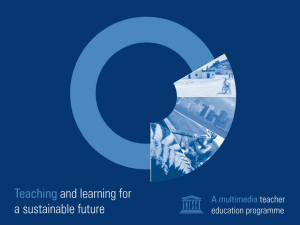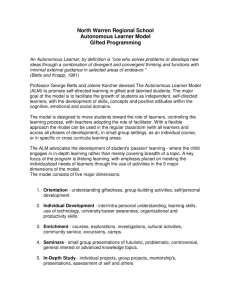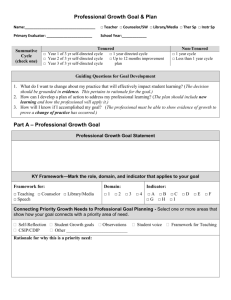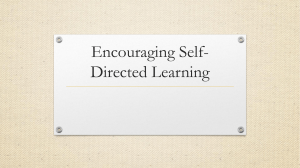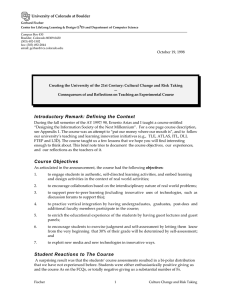Putting in work
advertisement
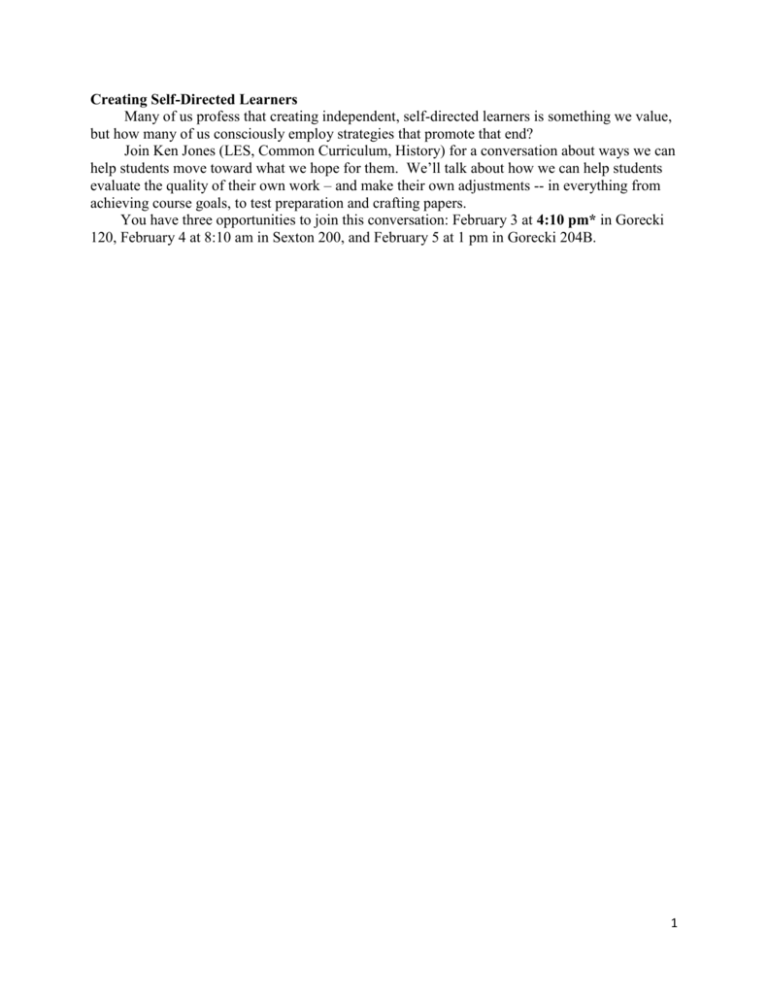
Creating Self-Directed Learners Many of us profess that creating independent, self-directed learners is something we value, but how many of us consciously employ strategies that promote that end? Join Ken Jones (LES, Common Curriculum, History) for a conversation about ways we can help students move toward what we hope for them. We’ll talk about how we can help students evaluate the quality of their own work – and make their own adjustments -- in everything from achieving course goals, to test preparation and crafting papers. You have three opportunities to join this conversation: February 3 at 4:10 pm* in Gorecki 120, February 4 at 8:10 am in Sexton 200, and February 5 at 1 pm in Gorecki 204B. 1 Creating Self-Directed Learners I’d like you to start by asking you to define what an independent, selfdirected learner look like at age 18 – or 22? What would make you happy? What would it be reasonable to hope for? Have everyone write down three things Can do 18 or 22 or combination Go around – What are people doing to achieve these dreams? Anything that you have found that works? When we think about how we would like our students to be, it seems to me that we need balance those expectations with a little reality. First, they aren’t us, and my guess is that most of us wouldn’t have measured up to our idealized standards if we could go back and do a realistic appraisal of what we were like at 18 or 19. Second, we need to remember that our students have been acculturated over 12 years in a system that – at least for the most part -- put a premium on learning just enough to get a gold star or a smiley face. If you hit the standard, then there was no point in going for more. Furthermore, the “standard” was set by someone else – the student had no agency – no power to shape the learning. 2 And remember, our students were very successful in this system. No wonder they only want to do enough to get an A, and are focused not on learning, but on hitting the standard – or to be more crass - pleasing us. Ok, so we need to find ways to change their vision – to nudge them in the direction we want. Don’t have answers to all of this, but let me share a few suggestions. There’s a movement that has been around since the 1980s called self-regulated learning. Most of focus has been on k-12, but some on higher education. Self-regulated learning theory poses a cyclical three stage process: Forethought Perceives task – what actually is involved, what do I need to do, know Sense of whether have skills, experience, knowledge Am I interested enough to put in work What is my goal – how high, performance or mastery How to proceed, what do I know about tackling this kind of work Performance Focus attention – avoid distractions Do the activity – put in the work Self-monitoring – ability to ask oneself if this approach is working, and shift if not Reflection Self-evaluation of how you did – measured against some standard Attribution – why did I perform at that level – good or bad 3 Self-reflection – a feeling of success, feeling of desire to do better – how feeling about the experience Adaptation – what should I learn from this – do same or change aspects Obviously, if students would do some or all of this, they would be on their way to begin the independent, self-reflective learners we want. So we have a problem and an outline of a system that would help. So how do we get students to do this? What I want to do with rest of our time is to point out some practical, concrete ways to move students along the process outlined in the self-regulated learning theory. Forethought Perceives task – what actually is involved, what do I need to do, know How do we help them accurately perceive the task? Think first I expect that I’m not the only one who has gotten a paper where the student has clearly done a lot of work, but quite obviously didn’t pay much attention to the question. For example, in my US Since 1960 course we look at Lyndon Johnson’s War on Poverty, and they have an essay option where they can use what they have learned to propose a better plan to the president – within certain parameters. My 4 goal is to get them to think about the nature of the problem, whether or not the solutions employed were appropriate, why or why not, and the barrier to doing something different. Too often, what I get is a student who reads “Lyndon Johnson” and “War on Poverty” and proceeds to write a summary that is very thorough and accurate but doesn’t really do what was asked. As far as I can tell, in most cases, they started writing without really thinking. So one key to perceiving task is thinking carefully. Another is making sure that all of the critical material is identified and organized effectively. Again, the idea is to head off writing before thinking. Use concept maps or outlines to sort through information Connections to prior work – having skills/experience Help them think about how this assignment is similar and/or different from what they did in this class or other classes. Better, if you have asked them to do some low stakes versions before a major test or paper, you can help them understand the similarities and differences so they can imagine what they need to do. Don’t just say it will be harder – work through. If you want to go a step further in helping them understand what is required, you can create a check list. Works for papers or lab reports. Often a bunch of mundane things – proper format, answered all parts of assignment, proper citations, checked for sloppy scholarship. Whatever bugs you –typical student mistakes Have them hand in checklist and paper. Of course they will check everything, but it starts the habit of remembering to check these. Surgeons doing this – big increase in safety in hospitals as a result. What about helping them move beyond the basics – to understanding what mastery looks like in greater depth. 5 “Feed-forward assessment, exemplars, and peer marking: evidence of efficacy,” by K Wimshurst, and M. Manning. Assessment and Evaluation in Higher Education, 38 (4), 451-465 Gave students 6 papers from previous year covering same basic information (though addressing a different question). Quality ranged from barely passing to excellent. Students were to select three of them, read, and grade. Students didn’t get a formal rubric, but rather a “tips” sheet. (NEED to include) Then had to write 100-150 words on each on why they gave it that grade. That paper was worth about 10% of semester grade. I see real value in this in that students weren’t focused on their own paper – and having the grade they received color how they responded to the comments. Instead, they were pushed to look at the work of other students – which in my experience they always enjoy doing and are pretty critical about – and asked to think through which paper worked best and why. Seems to me that that should have enhanced their ability to critique their own work. Professor then compiled the average grade given each paper, and posted a substantial selection of the student comments. Publication doesn’t mention it, but I can imagine that it would be really helpful at this point to spend 15 minutes or so talking about the comments, why students responded as they did, and the faculty member’s view. Students then turned in their own paper a few weeks later. Reported some improvement in quality of student papers, and some anecdotal comments on helpfulness of experience. Several noted that they had an increased awareness of the difference between “an essay done well and one done poorly.” Others saw examples of their own weaknesses in the samples, and were encouraged to improve. And interestingly, several gained an increased sense of class involvement from seeing the work of others. The Kristin Gehsmann entry in the bibliography does something similar, but focused on English majors. (why piece of writing works or doesn’t) 6 Performance Attention focusing, putting in work, self-monitoring Focus – Could have them discuss when they have felt they did best work Explain that multi-tasking not efficient Challenge them to try to do something academic in the totally focused way they do other things. Explain, get done faster, with better product, if focus Putting in work Clear statement not just of expectations, but how long it will take them Reminders on starting early Can also do more to help them see what is enough – CAT – muddiest point at end of class each day or several Ask them in the next class period what they did to clarify that point for themselves. And have people explain their answers. Choose a specific, easily definable course goal (Marilla Svinicki – NTLF) Ask students to respond to questions about how well they are achieving Then where they feel uneasy, an what they would need to understand Could do at mid-term, or at end of each unit As way to get them to reflect on larger goals And on their own efforts to comprehend them Self-Monitoring Effort to encourage students to think more about their work before they turn it in H. Andrade and Y. Du, “Student responses to criteria-referenced self-assessment,” in Assessment and Evaluation in Higher Education, 32 (2), 159-181 Students given rubrics and checklists with each assignment. Before turning the assignment in, they had to judge their work. So being forced to rigorously apply criteria developed by professor. Those self-assessments were turned in, but not graded 7 Students reported that prior to this their self-assessment efforts were “relatively mindless,” but requirement caused them to think enough to make revisions before they turned it in. Realized that careful self-assessment could lead to better grade. Second model N. M. Edwards, “Student Self-Grading in Social Statistics,” College Teaching, 55 (2), 72-76 Starts class by having students grade own homework (no homework, no credit). Professor passes out answer key with steps needed and other explanations. Students pay attention because they see their mistakes as they grade Professor collects, rechecks all for first weeks; then sporadically Grading your own work like this helps students see where they are making mistakes. Plus it is instant feedback. Shifts focus away from “how many points did I get” to learning how to do better. Students really like Empowerment Not part of self regulated learner literature – at least as far as I could see, but seems to me to be an important addition of we are going to help our students become self-directed learners First part of empowerment – Moving from teacher’s standards to creating their own image of excellence. Not saying they can do whatever they want, but guiding them and then allowing them to be part of the process. Ultimately, begin to take ownership of objectives and criteria. One example – 8 Katherine Robertson, Faculty Focus 4/1/13 Don’t simply tell them what we expect, but rather challenge them to determine for themselves what the characteristics of good work look like. Has students set own guidelines for writing a lab report – do in groups and then class as whole. Periodically revisit and revise if necessary over semester. Another option – have students write first draft of essay, then write short essays critiquing their own work and describing the improvements they think they should make, as well as the resources they will use to help them. Helps students move away from dependence on highly detailed guidelines provided by faculty to thinking through on their own what constitutes good work. http://www.facultyfocus.com/articles/educational-assessment/assessment-asan-opportunity-for-developing-independent-thinking-skills-instudents/#sthash.BfAThnJP.dpuf http://www.facultyfocus.com/articles/educational-assessment/assessment-as-an-opportunity-fordeveloping-independent-thinking-skills-in-students/#sthash.BfAThnJP.dpuf Empowerment in another form Many of our students – certainly in their first couple of years -- are used to a system where all the necessary information is provided by the teacher and it is their responsibility to memorize that information as much as possible. As a result, they lack the experience of questioning what is being discussed in class, developing their own arguments, and/or finding their own information. We do want them to do all these things, so issue is how can we promote them more consistently in a more conscious manner. Questioning/developing own arguments Frame discussion questions that require these skills Easier in Humanities and Social sciences than in Natural Science But can, even in content rich, have to know the right answer courses, I have seen people do this. Can get them to by raising hypotheticals – we know that if these molecules combine in this way, but what if we introduced x into the mix? Finding own information – 9 Using “messy” information rather than “correct, sanitized versions in textbooks. Are there places where instead of using an assigned book or reading, you can have them search – maybe just the internet – for information on a given topic. Individuals or groups Then use that for the conversation. Can discuss why certain answers are better than others, and what additional information would be necessary. Or – same idea – do a “how do we know whether this is true/accurate or not” question – send them to find the research that supports whatever the aspect is. 10 Reflection Goal here is to take a meta-cognitive look at the outcome. As you can see, calls for Self – evaluation of how student did Why that result – cause didn’t study or something else? How do I feel – successful? Ready to work smarter? What did I learn – what is necessary for success? Two examples First Students get feedback on paper or test or lab report Write memo to prof on how they interpret feedback – what do they think they need to do next time strategy (deep v. superficial) techniques – re-reading notes versus concept maps, etc last minute or steady work and review. Next paper – Include brief explanation of how they tried to improve approach Fancier E. F. Barkley, “Student Engagement Techniques: a Handbook for College Faculty, Jossey-Bass, 2009, 336-339 (have) After finishing exam, but before turning it in, they fill out questionnaire (push by requiring both in order to have exam count) Predict exam score Rate effort in studying for exam on 1-10 scale List specific learning strategies you used (ie, flash cards, re-write notes, create outlines, discuss with others, etc Identify what you found easiest and hardest on exam and why Return exam Do second analysis (may need to offer bonus to those who complete carefully) 11 Ask – Emotional response to exam grade Compare actual to predicted Identify where each question came from (in-class or elsewhere) and calculate the % of questions missed in each category. What does this tell you? Reflect on strategies you used and amount of time. Describe any changes you plan to make for next exam Do you have suggestions on how I or your classmates can help you better prepare for the next exam Based on your performance on this exam, set one goal for the next. Make the goal specific (ie, I plan to get at least 75% of questions from reading correct. Do this early in the course. Talk about why you are doing this and how it can help Key final points Pick one of these ideas – do not suddenly try to do a bunch And look for ways that your work encouraging student reflection can substitute for a more traditional paper. Don’t radically expand your workload. If you use techniques that promote any form of self-reflection, you are giving students the tools to become self-directed learners. Yes, using these things probably will make it harder to cover all the content you have done in the past. But that isn’t short changing our students. Remember it is about learning, not coverage – if we can give them the tools to learn more easily or learn on their own, we doing something much more powerful than covering a few more historical events. 12
